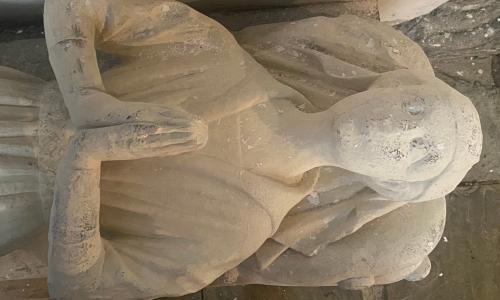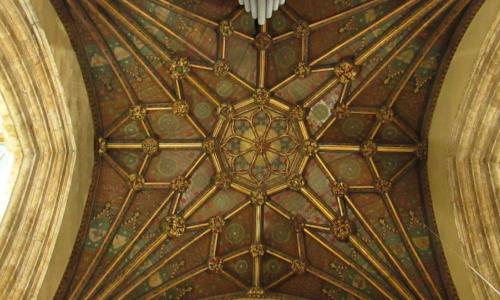The origin of the painting
This painting shows a family eating a meal. It is called “The Feast of the Holy Family” in English. The feast of the Holy Family is a sacred day in the church calendar and is celebrated on the first Sunday after Christmas. According to the Wallraf-Richartz-Museum in Cologne, where the painting is housed, the picture is likely to have been used in a domestic setting, and was painted by Jan Mostaert sometime between 1490 and 1500.
It reflects the Catholic values of the household. Mary sits with the baby Jesus on her lap, she is indicated buy a white headdress resembling a halo. She spoons milk into Jesus’ mouth. Opposite Mary, sits Joseph, symbolically paring dark cheese or bread with a knife. In front of the small group is a feast of food on a white cloth. At the very centre of the table right in front of Jesus, is a bowl which very closely resembles our Siegburg bowl. We do not know whether our bowl was used symbolically in the same way, or for communion. In those days, it was extremely unusual for communion wine to be distributed from anything other than metal. However, this scene of the Holy Family eating together may indicate that our bowl may have been used symbolically as a chalice.
There are symbols of Christianity dotted through the picture by the artist.
On the table you can see cheese, bread, a pear, a sugar loaf on a pewter plate, and a hot cross bun on a square board at the front of the table nearest to the onlooker, is a salt mill some bread and a flagon which could have contained wine. Many of them these things have a symbolic context.
The wine represents the blood of Christ which Christians drink at communion new line the bread represents the body of Christ which Christians eat at communion.
Salt on the table was used to ward off evil spirits.
The sugar loaf on a pewter plate resembles the head of a person and could have been intended to suggest the martyrdom of John the Baptist.
Behind the family you can see the traditional vessels commonly used for communion, the chalice, patten and ewer. There are also some carvings which resemble animals associated with St Luke and Saint Mark.
At the very back of the painting behind, the family, is a window with a cross at its centre. This indicates above all the religious nature of this picture.
About the artist
Jan Mostaert was living in the Dutch city of Haarlem when this picture was painted. Haarlem is next to Amsterdam and was a port. He lived there from the 1490s until his death. He was a member of the Haarlem Guild of St. Luke until his death in 1553.




